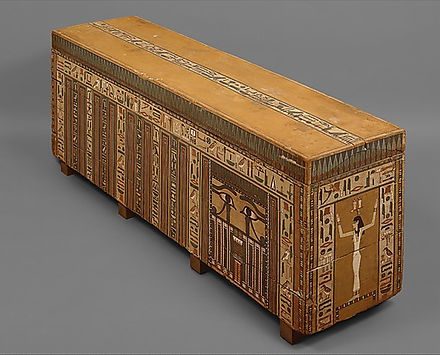Middle Kingom Art

"Coffin of Khnumnakht"
Period: Middle Kingdom, Dynasty 13
Medium: Wood, paint
Credit Line: Egypt
Location: Metropolitan Museum of Art
Salon 1: 4 paragraph description
The Egyptian civilization is known for it's creative art and design in areas like sculptures, paintings, and architecture. The Middle Kingdom began when Nebhepetre Mentuhotep reunited Upper and Lower Egypt. It was an age entirely for invention and experimentation, you could also say creativity. The painting of tombs became of great delicate craftsmanship. Also some of the finest known egyptian sculptures were built during this time. Block statues became a famous addition to egyptian art. Block statues mainly consist of a man squatting with his knees drawn up to his chest and his arms folded on top of his knees. The head of this sculpture has the most detail.
Many royal sculptures of Sesostris and Amenemhet showed great extents of realism. The sphinx became a commonly used form for kings in order to show them as the great protectors. Most sculptures would be more detailed in the face rather than in the body region. In egypt during the middle kingdom no person or family ruled at the time. This gave the citizens much more freedom to be creative and express themselves. This time was very important for egyptian art because it took on many new styles and forms.
The piece I chose to look more closely in depth on is that of a coffin from the Middle Kingdom in Egypt. The Medium of the coffin is wood and paint. It is located in the Metropolitan Museum of Art. And the coffin is said to have been of Khnumnakht. As an observer it is easy to see a lot of time must have gone into the overall painting of this coffin. Since even though the mediums are pretty simplistic the designs painted on the coffin itself are inticate and detailed. You can tell that the egyptian people had extreme high regard and value for their Pharohs, Kings, or leaders. Due to the way they build their resting places for the afterlife.
The Egyptians seemed to not be afraid to use color because from the painting on the coffin it is creative in both the design and the assortment of colors used. Even though the artist is unknown his talent cannot be overlooked by the way each Hyeroglyph is decorated seperately. The eyes on the coffin are drawn to enable the mummy to be able look out into the world. The coffin is also decorated with a palace facade on it's sides as well as inscriptions. The body inside the coffin was found to be laid on it's back with it's face towards the east, where the sun rises.


